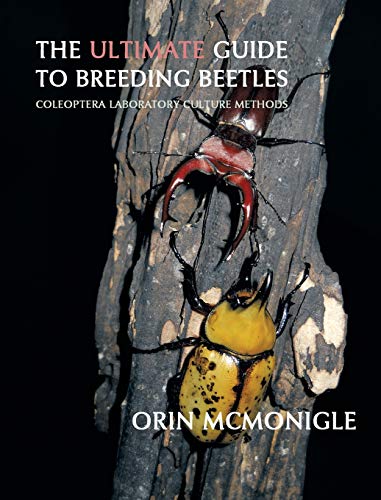Ox beetles are one of the best pet beetles for beginners due to their short life cycle, ease of care and accessibility. In this article, I’ll teach you all I know about keeping Ox beetles, Strategus aloeus.
Introduction to Ox Beetles
Ox beetles are scientifically known as Strategus aloeus. It is native to the Americas, where it can be found in southern North America, Central America, and certain parts of South America (check out their distribution map).
The male Strategus aloeus has 3 horns. It is unique in the sense that all the 3 horns are located on the thorax, and none is on its head. Since there is no cephalic horn, the male beetle is not able to maneuver the horn to attack and pinch its foes, unlike other beetles.
Ox beetles have a short life cycle, where it takes merely 8-10 months for the beetle to become an adult. This is fairly short compared with other beetles, such as Hercules beetles and elephant beetles. After emerging, the adult beetle can live for another 3-6 months.
An ox beetle measures somewhere between 35-55 mm in length, including the horn.
Note that ox beetles are agricultural pests, as they damage the roots of plants. Never release them to the wild!
Recommended Resources and Supplies
Here are my recommended supplies and resources that you can consider getting for your ox beetles. I’ll earn a small commission from eligible purchases you make after clicking those links. It helps me maintain this site without additional cost to you.
The Ultimate Guide to Breeding Beetles: Coleoptera Laboratory Culture Methods

I call this book the encyclopedia of beetle keeping. It contains comprehensive information on rearing all sorts of beetles, including the rhinoceros beetles, stag beetles, flower beetles, dung beetles, and so on. Whether you are a beginner or expert in beetle keeping, this book definitely blows your mind. While it is not cheap, it is definitely worth the money!
Other Supplies
- Housing for adult beetle
- Substrates for adult beetles
- Beetle Jelly
- Nursery housing
- Housing for grubs
- Heat mat
- Thermometer & Hygrometer
Getting Ox Beetles
Depending on where you are located, you can find ox beetles from breeders online. Always get the grubs, so that you can enjoy the full experience of keeping beetles. Moreover, it is not possible to ascertain the age of an adult beetle. You will risk buying an old beetle if you go for the adults.
As a general rule of thumb, first and second instar grubs have a higher mortality rate than the third and fourth instar grubs. Try to get a few third or fourth instar grubs, since not all of them will survive.
If you happen to live where ox beetles can be found, you can try catching them. At night, hang a white blanket in an open field, away from the city. Then, flash black light onto the blanket. With some luck, you can attract the beetles and capture them.
There are 2 issues with catching ox beetles. First, you need to be lucky! Second, you will be getting adult beetles of unknown age. But at least they are free!
Caring for Grubs
Ox beetle grub care may seem easy and dull. Unlike other insects, you can’t easily notice when things go wrong, since the grubs are always hiding. Hence, it is important to read and understand this section to prevent harms to the grubs.
Preparing Flake Soil
Ox beetle grubs are cryptic creatures feeding on decaying wood. In this hobby, decayed wood is prepared as what we call the flake soil. You can make your own flake soil by referring to my recipe. Make sure you have the flake soil ready before getting your grubs!
Add water to the flake soil. Mix evenly until the flake soil is adequately moist, but not too wet.
So, how moist is adequate? Grasp a handful of flake soil tightly. If no water drips out and the flake soil retains its shape briefly after being released, you have successfully achieved the required moisture.
Add more flake soil if the mixture is too wet, and add more water if it is too dry.
Housing the Grubs
You can either house your grubs individually in separate containers, or communally in the same container. It is advisable to house them separately if you want to get a bigger adult beetle. Moreover, if things go wrong in 1 of the containers, only 1 grub is affected instead of all grubs.
Prepare a plastic container for your grub. For the first and second instars, you can use any 250 mL plastic coffee cups with a lid. For third and fourth instars, use 500 mL and 1 L containers respectively.
Fill up the plastic container with moist flake soil prepared earlier. Press lightly to compress the flake soil. Then, place the grub onto the flake soil, and cover the container. Be sure to poke some holes on the container for ventilation.
Place the grub in the dark, somewhere between 24-28 °C (~75-82 °F). Temperature control is required if you want to get a big beetle.
Do not disturb your grubs. You may feel insecure or uneasy if this is your first pet beetle. But trust me, don’t try to dig out your grubs every now and then just to check in with them. They prefer to be alone, undisturbed.
Replenish Flake Soil
Check the flake soil in the enclosure once every month or two. The grubs should have finished most of the flake soil, leaving mostly their excrements.
Remove all the spent flake soil, and wash the container thoroughly with mild detergent if you are reusing the same container for the grub.
Put new, moist flake soil into the container, like what you have done before. Except for this time, add in some old flake soil. The old flake soil contains beneficial microbes that can help your grubs grow better. Don’t use the old flake soil if it is evidently infested by mites or molds.
Molting Care
When replenishing flake soil, you may notice your grub lying there, immobilized. Don’t be alarmed. It is probably molting. Leave it alone, and avoid touching it because it is extremely vulnerable during this time. I normally defer flake soil change when I see my grubs molting.
Pupation
When the ox beetle grub is about to pupate, its body will turn yellowish, and enter what we call the pre-pupal stage. If you see the pre-pupal when changing flake soil, this should be the last time you change flake soil for your grub.
Make sure you press the flake soil firmly when doing the last flake soil change. This makes it easier for the grub to build its pupation chamber.
The pre-pupa grub will soon construct a pupation chamber using both the flake soil and its frass. It then stays inside the pupation chamber, and morphs into a pupa. It takes about 6 months from hatching to pupation.
Do not change flake soil anymore after you see a pre-pupa. This is because you may destroy its pupation chamber. If this happens, you will need to resort to an artificial pupation chamber.
Adult Ox Beetle Care
About 1-2 months after pupation, the pupa will emerge into an adult beetle. The adult beetle stays inactive in the pupation chamber for 1-2 weeks before exiting.
Once the ox beetle leaves its chamber, transfer it to another container. This length of the container should be at least 3 times the length of the beetle, and the width and height should be at least twice its length.
Put some hays or potting mix in the container. Add some cork bark or branches for the beetle to hold onto in case it topples itself upside down.
Feed the ox beetle with cut fruits or beetle jelly. Most hobbyists use beetle jelly, since it’s easier to use and keep. I have a beetle jelly recipe that you can refer to.
I always put the food on a sauce dish to keep the container clean.
Ox beetles are nocturnal creatures. Hence, keep them away from direct light. You may use a display light when observing your beetle, but remember to turn it off after that.
Breeding Ox Beetles
To breed ox beetles, you need suitable male and female beetles. Preferably, both beetles are at least 1 month old, but not too old. This will result in more eggs and better hatchability.
First, keep the male and female beetles in the same enclosure. They will naturally mate. If you are unsure whether they have mated, simply leave them together for a week.
Meanwhile, prepare a nursery chamber. You can use any big storage container that has a lid. Poke a few holes for ventilation.
Mix moist flake soil with dried leaves in the ratio of 4:1. Fill up the container with the mixture, and press the substrate firmly until it is around 10 cm (~4 inches) in depth.
Add another 2-3 cm depth (~1 inch) of loss substrate on top, without compressing. Lastly, put some barks on the substrates, so that the ox beetle has something to grab and recover when she falls upside down.
One week after mating, move the female beetle into the nursery chamber. Give her a beetle jelly, and leave her alone. She may or may not feed on the jelly. Nonetheless, replace the jelly whenever necessary to prevent molds.
Check the substrates 1 week after you introduce the female into the nursery chamber. If everything goes well, you will find the eggs! Normally, ox beetles can lay between 60-100 eggs.
Because the eggs are small and fragile, it is not recommended to remove them. Leave them in the nursery chamber. The ox beetle eggs typically hatch in 2 weeks.
After 6-7 weeks, the grubs should be in second instar. You can now safely transfer them to individual containers.

